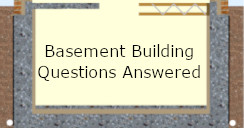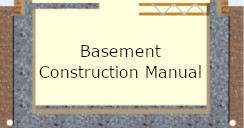| |
How to make sure you get a dry basement.
Your new basement can be built dry with just waterproof concrete, powerful plasticiser, steel reinforcement and good workmanship.
Fancy, expensive products don't usually work anyway.
What works is avoiding all the causes of leaks.
I list all the causes of leaks lower down this page.
Another pages shows some of the many successes, while this page concentrates on what not to do.
|
|
|
Basement waterproofing has changed. BS 8102 has been re-written and re-issued.
•
Internal drainage and an Insurance Backed Guarantees for the installation are OUT. Neither comply anymore.
•
Building with better choices and repairing the structure till it doesn't leak, which require a complete about-turn from the design team, contractors, inspectors and insurers, are IN. The basement structure can be guaranteed not to leak by the contractor and backed up with an Insurance Backed Guarantee the basement won't leak.
I have built domestic basements for the past 18 years. Arguing all the time that dry from good workmanship was better than hiding the leaks behind a membrane.
Time has proven me right because hiding the leaks has led to more and worse leaks. More water led to more pumps burning out and discharge pipework splitting. Pumps and pipework are not covered by structural warranties or insurance backed guarantees.
The whole industry, from design team to insurer, found a way to take the client's money yet fail the client or his new house buyer who clean up the flood and foot the bill.
last year BS8102 significantly changed.
I review BS8102:2022 here.
One step at a time I changed my way of forming reinforced concrete to reduce the causes of leaks.
Since 2013 nothing built my way, easily over 100 basements, has ever had a single drip of water get through or over the structure.
It is perhaps very important to note that the new Standard requires "Relevant manufacturers product information should be checked to confirm that the system selected is suitable for the structure for which it is to be applied".
It is surely no longer acceptable to tick a box because a product has a BBA certificate. Too many BBA certificates provide evidence that the product is of no benefit or is slightly disadvantageous. The common practice of ticking a box without reading the document could last a long time. You need to change this culture within your own design team. Question your design team, check they really understand certificates. Checking to Confirm requires reading and fully understanding. Do they?
The new Standard requires contractors to keep returning to fix leaks, as I used to but haven't needed to since 2013.
First. Your part within the process must back up the requirement that methods and workmanship should be better, rather than require leaks to be covered over.
Second. Building a structure Right First Time so it never leaks is very simple. Contractors need to be told to build differently with none of the causes of leaks. The feedback I receive tells me building well doesn't cost any more.
The causes of leaks through basement structures are:
-
Too much water in concrete of insufficient density.
-
Readymix producers can make a waterproof concrete mix very easily. But it is dry and too stiff. It needs a powerful water-reducing plasticiser admixture NOT a waterproofing Chemical. No water should be added at site.
-
There is no such thing as a chemical that will waterproof non-waterproof concrete used beneath ground where it will never fully dry. But there are a lot of tall tales out there that actually rely just on the powerful plasticiser.
-
More horizontal distribution steel is required to restrict thermal shrinkage crack widths to what will self-heal (autogenous healing).
-
How much more steel depends upon the cement-type supplied in the concrete. It can be best to plan for the worst.
-
All joints should be scabbled, cleaned and kept clean to BS8007.
-
Tapes and strips in poorly prepared joints do not work. In well-prepared joints they are superfluous.
-
Concrete kickers leak and they are impossible, almost, to waterproof later.
-
Many other systems of kicker are available.
-
Leaving tie bar holes through otherwise waterproof concrete.
-
It is not practical to expect hundreds of holes to all be repaired properly.
-
Pouring walls more than 2m high at a time prevents the concrete getting to the bottom in good condition and prevents the poker compacting the concrete at the bottom properly.
-
The usual practice is to cosmetically repair honeycombing but these repairs leak.
-
Concrete needs the moisture within it for the correct chemical reactions to take place sufficiently.
-
Formwork should not be loosened, let alone removed; and floor slabs need to be prevented from drying out for 72 hours at least.
-
The choice of floor over a basement should not cause water to leak in over the retaining wall.
-
I invented continuing the retaining wall to above outside ground level as an upstand, which I see has been fairly widely adopted already.
-
The Standard requires one form of defence against ingress of water to be continuous from basement slab to above outside ground level – concrete fits the bill better than anything else.
-
The Standard warns against many types of material: beam and block, sticky back membrane, twin wall, blockwork, ICF etc.
-
SUPERVISION. The new Standard places great emphasis on supervision.
-
The secret of my success is my supervision of all concreting and joint preparation.
-
The walls and joints in the concrete must be exposed by removing all the formwork; inspected and repaired as appropriate.
-
The basement must be left clear until
-
The roof is on, the windows are in and the structure above is fully weather tight.
-
Then the basement needs pumping empty of all the rainwater that collected. It should be dried and cleaned.
-
Some ventilation needs to be in place to prevent condensation, because condensation can look a lot like a leak.
-
The basement needs inspecting again after a period of heavy rain and any leaks through the structure fixed.
OF COURSE, IT IS A LOT EASIER TO HAVE BUILT WELL ENOUGH IN THE FIRST PLACE NOT TO HAVE ANY LEAKS.
A BBA certificate is a wholly inappropriate form of evidence that concrete is waterproof.
Every working day thousands of cubes of sample concrete are taken from sites to a lab where they are crushed to measure the compressive strength of the concrete actually used on site. This test is to BS EN 12390 part 3.
More cubes can be made and tested at the lab to BS EN 12390 part 8. Resistance to penetration of water under pressure. Less than 20mm of penetration by water held under 4 bar of pressure for 96 hours is a pass.
A pass can be obtained without any expensive additive. With a powerful plasticiser a waterproof mix of concrete should be completely impermeable.
|
Back to the Basement Building Questions Answered menu.

|
Forward to the Basement Building Construction Manual menu.

|
For a fixed fee of £199 I will answer all your questions by email. More details here.

|
Previous Page

|
|
Next Page

|
|
The Page After That

|
|
|

